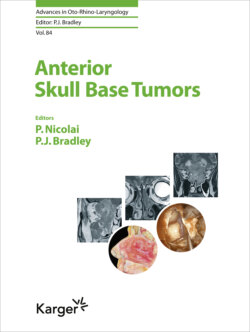Читать книгу Anterior Skull Base Tumors - Группа авторов - Страница 100
Complications
ОглавлениеAlthough endoscopic surgery resection of sinonasal tumors is associated with lower morbidity, better postoperative quality of life [17, 18], and faster hospitalization days [3], as in any surgical intervention postoperative complications can occur. Nonetheless, after these procedures they are less severe and frequent compared to traditional open approaches [19]. From the reports available in the literature on endoscopic management of sinonasal tumors, it is evident that the rate of complications is 9–11% [19–30], while the mortality rate is around 0–1% [22–24]. Complications and mortality rates of open approaches, which are 36.3 and 4.5%, respectively [22], confirm that endoscopic strategy is a safer and less invasive procedure (Table 2). Of note, the analysis of retrospective series frequently has a low statistical value, since the comparison is made between cases with variable extent and histology.
In general, potential complications can be divided into five main groups (Fig. 3):
1Systemic (sepsis, fever).
2Central nervous system (meningitis, brain abscess, pneumocephalus, cranial nerves injuries, etc.).
3Orbital (orbital hematoma, pneumorbit, epiphora, etc.).
4Vascular (intraoperative bleeding from sphenopalatine, ethmoidal, frontopolar, medial orbitofrontal, or internal carotid arteries [ICA]; nasal bleeding after nasal packing removal). Although the injury of ICA during an endoscopic procedure is luckily a rare event (0.2–1%) [23], the progressively expanded indications for endoscopic surgery have led the surgeon to more and more frequently deal with lesions deeply related with the ICA. Several authors have published their experience regarding this issue [26], reporting 7 ICA injuries in 2,015 endoscopic endonasal skull base cases over a 13-year period (only 1 case occurred in managing 256 cases of sinonasal malignancies); the mortality rate was about 17% with a mean blood loss of 1,600 mL (range 400–4,200). The authors proposed strategies to prevent injury and, in case of ICA damage, to deal with it: anatomical knowledge, preemptive vascular control via a neck incision, careful preoperative assessment of imaging and planning, early endovascular assessment with angiography, surface with mucoperiosteal flaps or grafts of the exposed ICA. In our experience, in agreement with that of other authors [23], and in addition to meticulous preoperative radiological evaluation (angio-TC and occlusion test), we consider the magnetic neuronavigation system and the Doppler-ultrasound instrumentations to be indispensable intraoperative aids.
5Skull base reconstruction failure. From the data available in the literature it emerges that the most common major complication of skull base reconstruction is cerebrospinal fluid leak (CSF-L) in the postoperative period, with a prevalence of 3–4.3% [22–24]. A recent report published by an Italian center has shown a CSF-L rate after anterior skull base reconstruction of about 5.8% [27]. Another series from an Italian center analyzed 62 patients who underwent endoscopic tumor removal: the authors found that the risk of CSF-L is related to the learning curve of the surgeon and refinement of the surgical technique [16]. Even other reports published in the literature, such as that from the University of Pittsburgh Medical Center, have shown that the surgical experience plays a strategic role in the success of anterior skull base reconstruction after tumor removal with a CSF-L rate as high as 20–30% in the case of early reconstructive experience [24, 25]. As a last remark, the risk of brain herniation, a rare and life-threatening complication, may occur more easily in cases of intracranial hypertension (high BMI, OSAS), and in concomitant neck dissection with the injury or postoperative thrombosis of a dominant internal jugular vein [20].
